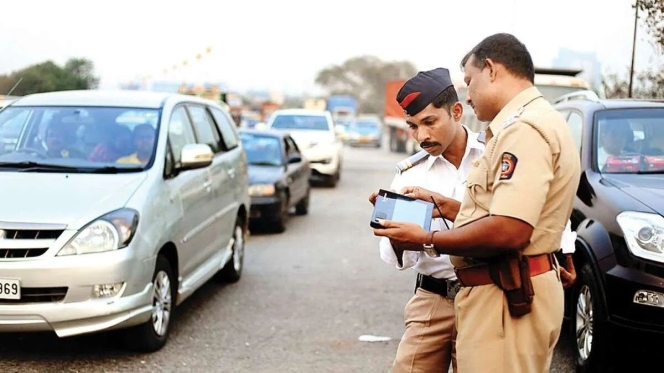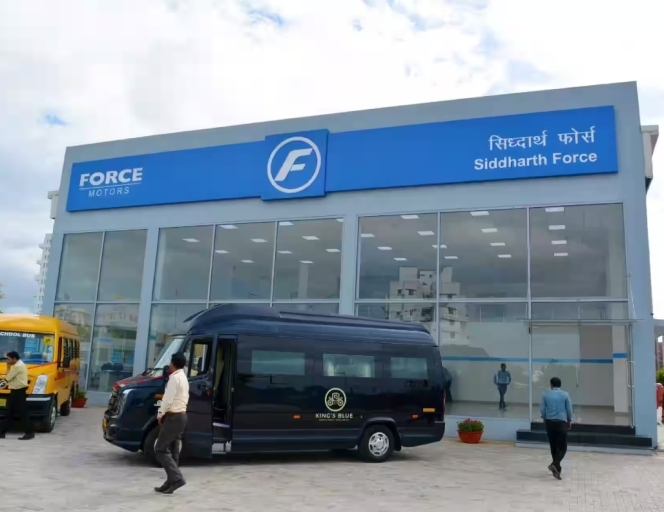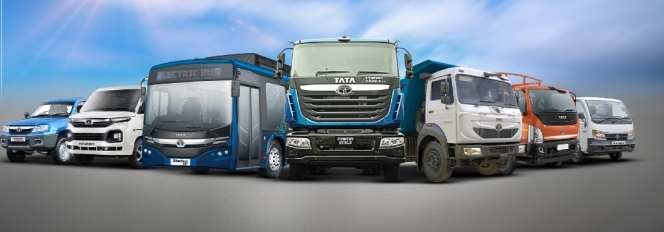E-Challans Find A Way to Annoy Transporters; To Agitate Them
- By Bhushan Mhapralkar
- December 18, 2024

Introduced by the Ministry of Road Transport and Highways (MoRTH), Government of India, in 2017 on a pilot basis by the Mumbai Traffic police in October 2016, the e-challan system has since been put into practive all over the country. Aimed at digitising the process of traffic violation enforcement by eliminating manual loopholes, the system is proving to be annoying for transporters however.
It is not the technology, but the ones who deploy the system, claims transporters. Stating that the e-challan system has over time become a source of significant distress for transporters even though its introduction was appreciated by the industry as it digitised the process of traffic violation enforcement and eliminated many manual loopholes, Bal Malkit Singh, Chairman - Core Committe and Former President, All India Motor Transport Congress (AIMTC), averred, "The system has over time become a source of significant distress for transporters and other road users. It has become a new ‘Frankenstein’ and death knell for the road transport sector.”
Stating that a strong resentment is brewing and the transport fraternity across the country is agitating, Singh said, “The intention behind e-challans is to improve transparency and reduce manual intervention, but several issues have risen to complicate the situation for transporters.” “The primary issue stems from the large volume of incorrect or excessive e-challans issued to them. Many trucks plying long distances are receiving multiple e-challans for the same alleged offense or due to erroneous readings from speed detection or overloading devices,” he added.
Giving an example of trucks travelling through multiple states often receiving fines for supposed infractions such as over-speeding or minor overloading even though they are within legal limits, Singh explained, “Such errors accumulate and led to a financial strain for transporters. This is exacerbated as transporters operate nationwide – covering diverse terrains and jurisdictions – that would mean that they may be penalised in various states.” “These fines often lack clarity or the chance for immediate redressal, leading to confusion and increased operational costs,” he elaborated.
Informing that enforcement officials have found a way around technology to generate motivated challans without any verifiable proof of offence, which is leading to acute harassment of the transport fraternity, Singh articulated, “There is neither authentication of any violation through static photo nor there is any transparency leading to acute harassment of the transport fraternity. Static photo of a parked vehicle is clicked and challans are issued for random offences. The vehicle owner may be from a geographically distant state and cannot contest the challan in court. Lack of communication regarding issuance of e-challan to the vehicle owner/operators who is sitting in one part of the country and must travel across the length and breadth of it to get it disposed/rectified.”
With instance where the vehicle owner comes to know of the challans issued only after he tries to dispose of his vehicle, goes to renew its fitness and to renew the permit (in the case of commercial vehicles), the issues with e-challans is pan-India in nature than be limited to a certain geographically or cultural area it looks like.
Transport associations like the All India Motor Transport Congress (AIMTC) have voiced concerns and are actively engaging with state and central authorities to address the growing problem. They have raised issues related to inaccurate e-challans due to technical errors or faulty detection equipment, lack of a unified system across states leading to inconsistency in how fines are issued and difficulty in contesting these fines as there is no streamlined process for redressal or appealing incorrect challans.
They are demanding a centralised and transparent grievance redressal system, standardisation of e-challan policies, equipment calibration across states and leniency or waiver of penalties that are clearly issued due to system malfunctions, according to Singh.
Of the opinion that traffic enforcement is a state subject, Singh expressed that the intensity and frequency of issues differ state-to-state therefore and in some states use of faulty equipment or overly strict enforcement practices that has led to a higher number of incorrect challans. Singh drew attention to issues like non-integration with national vehicle databases (such as Vahan 4) in some states. “The system in Telangana for example,” Singh articulated, “has been of specific concern for transporters because it is not fully integrated with the national system, leading to problems like wrongful issuance of challans for vehicles from other states.”
"The potential solutions to addressing the issue of e-challan," Singh commented, “Is to ensure scientifically verifiable evidence. A centralised grievance redressal system with a nodal officer should be put in place. The exact recording of the offence with exact measurement in case of over-height or overload or similar such case should be presented rather than a picture to avoid any doubt about motivated action. Equipment and procedures should be standardised. Vehicle databases should be integrated. Enforcement officials should ne trained to be humane. The accountability of the enforcement officials should be ascertained whenever the issue of motivated challans is there."
Image for representative purpose only.
Caterpillar And Nvidia Partner To Integrate Physical AI Into Heavy Industry
- By MT Bureau
- January 08, 2026

Caterpillar has announced an expanded collaboration with Nvidia to develop AI-enhanced solutions for machines, manufacturing facilities and supply chains. The partnership focuses on applying physical AI to heavy equipment to assist with autonomy and site management.
The automaker is utilising the Nvidia Jetson Thor platform to enable real-time AI inference on its construction, mining and power equipment. This technology provides a foundation for autonomous operations and in-cab assistance. Machines will process sensor data via edge computing to provide safety alerts, productivity tips and real-time coaching to operators. In mining and construction environments, these systems are designed to process data points in milliseconds to navigate changing jobsite conditions.
At CES 2026, the company debuted the Cat AI Assistant, a tool embedded in digital and onboard products. Built using Nvidia Riva speech models, the assistant uses voice activation to help users manage equipment settings, perform troubleshooting and access maintenance information. The system draws from Caterpillar’s Helios unified data platform to provide context-specific recommendations to dealers and customers.
Caterpillar is also implementing an Nvidia AI Factory to automate manufacturing processes, including forecasting and production scheduling. The company is developing digital twins of its factories using Nvidia Omniverse and OpenUSD. These virtual models allow engineers to simulate and optimise factory layouts and production flows before physical implementation.
Joe Creed, CEO of Caterpillar, said, “As AI moves beyond data to reshape the physical world, it is unlocking new opportunities for innovation – from job sites and factory floors to offices. Caterpillar is committed to solving our customers’ toughest challenges by leading with advanced technology in our machines and every aspect of business. Our collaboration with Nvidia is accelerating that progress like never before.”
Jensen Huang, Founder and CEO, Nvidia, said, “For a century, Caterpillar has built the industrial machines that shaped the world. In the age of AI, Nvidia and Caterpillar are partnering across the full spectrum – from autonomous construction fleets to the AI data centres powering the next industrial revolution.”
Force Motors Sells 2,952 CVs In December 2025
- By MT Bureau
- January 02, 2026

Pune-headquartered automotive major Force Motors has reported domestic wholesale growth of 49 percent in December 2025, reaching 2,952 units compared to 1,985 units in December 2024.
The automaker stated that for YTD FY2026 it sold 24,920 units, marking a 25 percent growth over the same period last year.
Quarterly performance showed momentum with Q3 domestic wholesales rising 47 percent to 8,427 units, up from 5,723 units in the corresponding quarter. The company attributed these figures to demand across its vehicle platforms, specifically the Traveller and Urbania ranges. According to the company, the tour and travel segment is showing signs of revival through fleet expansion and intercity movement, while school mobility remained steady.
Prasan Firodia, Managing Director, Force Motors, said, “December has been another strong month for us, and it is encouraging to see positive momentum across our core platforms. We are beginning to witness clear signs of revival in the tour and travel segment, supported by rising intercity movement and renewed fleet expansion. School mobility has also remained steady through the holiday period, reflecting growing institutional confidence as we head into the new year. The continued traction for Urbania across urban and emerging markets, along with the commanding market leadership of the Traveller range, underscores the trust customers place in Force Motors. Together, these trends point to a broad-based strengthening of demand and give us a solid foundation as we step into 2026”.
Tata Motors Sells 107,918 CVs In Domestic Market In Q3 FY2026
- By MT Bureau
- January 01, 2026

Mumbai-headquartered Tata Motors has reported its domestic commercial vehicle (CV) sales of 107,918 units for Q3 FY2026, which marks an 18 percent YoY growth, as compared to 91,260 units sold last year.
For December 2025, domestic CV sales stood at 40,057 units, up 24 percent YoY, over 32,369 units sold a year ago.
On the other hand, the company sold 2,451 units in the international market, up 63 percent YoY.
Girish Wagh, MD & CEO, Tata Motors, said, “The sales momentum ignited by GST 2.0 and the festive surge in Q2FY26 continued into Q3FY26, driving growth and lifting overall sentiment of the commercial vehicles industry. Tata Motors registered double-digit sales growth in Q3FY26, powered by a strong rebound in construction and mining activity post the extended monsoon, along with sustained demand from core sectors and auto logistics. Continued strength in SCVs and Pickups further amplified performance, resulting in wholesales of 115,577 units, with 21 percent YoY growth over Q3FY25 and 22 percent sequential growth over Q2FY26. Going forward, we expect demand to strengthen in Q4FY26 across most commercial vehicle segments. Key drivers in 2026 will include the government’s sustained infrastructure push and expansion in end-use sectors, both of which are expected to fuel positive momentum for the industry. With an optimised portfolio ensuring superior product availability, a decisive pricing strategy, and deeper customer engagement through intensified market activations, Tata Motors is well-poised to unlock demand across segments, paving the way for continued success.”
Dongfeng Launches X9 Tractor In Vietnam
- By MT Bureau
- December 31, 2025

Chinese automotive major Dongfeng Motor Industry (DFMIEC) has launched the Dongfeng X9 fuel tractor in Vietnam.
The company showcased the X9 tractor alongside other models, including the X7 tractor, X3 tractor and various cargo trucks.
The event included technical briefings on the fuel performance and mechanical specifications of the X7 and X3 models. Currently, Dongfeng tractors rank among the top five CV players in the Vietnamese market. The introduction of the X9 is intended to expand the company's product matrix as the local government seeks to reduce logistics costs and transition towards high-quality transport infrastructure.
Wang Long, Chairman of DFMIEC, said, “Vietnam is one of the most dynamic and promising countries in the ASEAN region, with its industrialisation and urbanisation processes accelerating continuously, bringing broad growth space for the logistics industry. Driven by three major favourable factors – the expansion of infrastructure and logistics networks, the transfer of manufacturing industries and the rapid development of the digital economy, the market demand for logistics and transportation vehicles has maintained a steady growth. DFMIEC will move forward hand in hand with its partners to contribute to the development of Vietnam's transportation industry.”
The principal of the Vietnamese partner noted that the collaboration has reached a deeper level with the arrival of the X9. Dongfeng plans to continue its international strategy by investing in localised development and expanding its overseas footprint. The company intends to focus on resource investment to support the upgrading of the logistics sector in the ASEAN region.







Comments (0)
ADD COMMENT